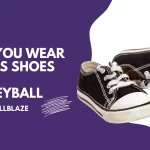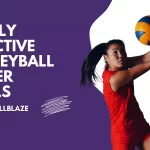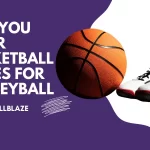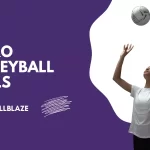Generally speaking, outside hitters in volleyball are considered to be the rock stars of the volleyball court, and for good reason…
The best offensive players are usually dexterous and can step back and pass the ball effectively.
Sometimes referred to as left-side hitters, wing spikers, or pins, left-side hitters hit the ball from the left side of the court.
When play gets scrappy, outside hitters are often the first to get the ball over the net because they are set more balls than the other players.
We’ll take a closer look at the roles and responsibilities of the Outside Hitter Volleyball Position and how you can improve your performance.
What Does An Outside Hitter Do In Volleyball?
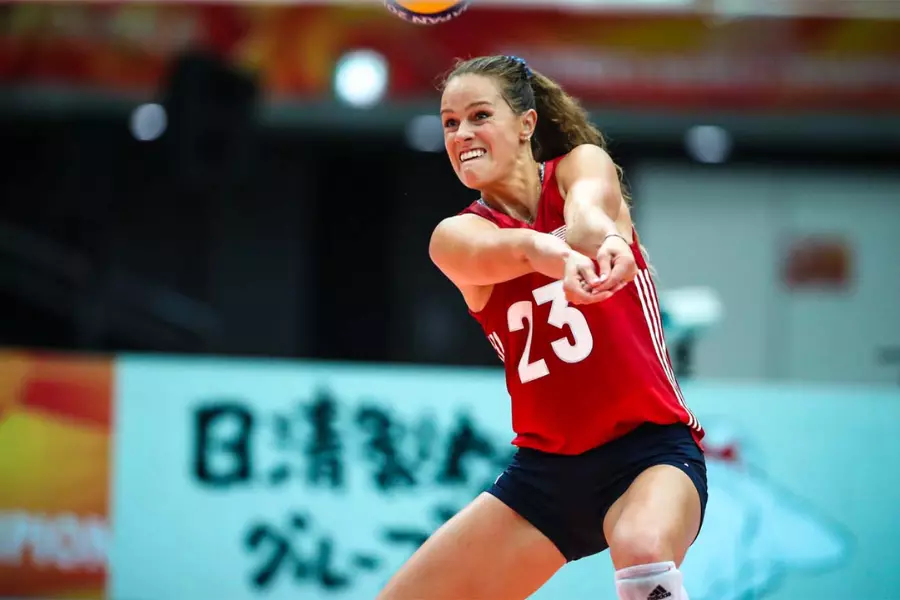
The outside hitter’s role is to pass the ball first and then hit it. They are called ‘passer hitters’.
It all starts with service reception, though it’s far less glamorous.
Pass from position 5 and hit from position 4 on the left side of the court.
My full article on volleyball positions explains these numbers in more detail.
The majority of people envision outside hitters as highly athletic, powerful frontcourt players.
Outside Hitter’s Role Is Crucial
Like an out-of-tune opera singer, an outside hitter who can’t pass is like a hard hitter who can’t hit.
A volleyball outside hitter’s primary responsibility is passing the ball.
Most outsiders are pretty average at passing – or at least much worse than the liberos – and are often targeted by the opposition server from position 5.
A quick transition to an offensive approach occurs once the pass has been made by the outside hitter.
Outside hitters are the main spikers
Usually, outside hitters receive more balls than opposites or middle blockers.
The setter can see them, which makes it easier for them to set to the outside.
It is also easier for a setter to push a release set to the outside hitting window when he receives a bad pass.
As a result, outside hitters have to hit some pretty difficult sets, especially at the youth level.
Juniors tend to be more athletic and more consistent spikers than opposites, so setting them a little more frequently makes sense.
Furthermore, they usually attack from the middle back zone of the court, using a pipe to hit from the back row.
The outside hitter must be able to block and dig
In the event that the outside hitter does not set the ball, he or she must immediately shift into a defensive coverage position and dig out the ball while covering the blockers.
It is the outside hitter’s first responsibility to block the ball after their own team serves it.
In this situation, the outside hitter will face the opponent’s opposite hitter.
The outside blocker assists the middle blocker
The outside hitter may decide to stay closer to the middle of the net while blocking in order to assist the middle in defending against the strong front-court setter and back-row hitter.
Defensive communication is also important for outside hitters.
It is important for them to inform the middle blocker if they will be hanging in to assist with blocking.
You may enjoy reading What is a Defensive Specialist in Volleyball?
What Are The Strengths Of A Good Outside Hitter?

There are many differences between outside hitters opposite hitters and middle hitters. As summarized below, they each possess unique characteristics and abilities.
Outside hitters are excellent passers
It is common for weak outside hitters to be pretty good spikers, but fail to pass accurately.
Because the outside hitter is passing the ball poorly, the servers will relentlessly target him, and he may begin to become a liability.
Serve reception is a key skill for the best outside hitters.
Outsiders are relatively good at hitting the ball at the highest levels. However, the best outsiders are far better at passing the ball.
A good outside hitter is the smartest attacker
It is common for weak or inexperienced outside hitters to be one-dimensional. Whenever they hit the ball, they hit it consistently with the same speed and direction.
Sometimes, they get blocked by the opposition when they have time to adjust.
It is quite common for great outside hitters to use the block to score points by hitting the ball high or swiping the ball off the block and out of bounds.
They are known as technicians.
With a wide variety of different shots and tempos, they have a large toolbox at their disposal.
It is common for them to roll, tip, and push the ball.
It is simply a matter of hitting the ball harder that makes the best outside players.
Besides using side spin to maneuver through the block, great outside hitters also control the ball with side spin.
Additionally, the ball is never predicted where it will land.
There is virtually no difference between attacks regardless of the set.
High-jumping, athletic outside hitters
Outside hitters are often more athletic and explosive than opposites and middle blockers.
An excellent outside hitter is a powerhouse who usually jumps higher than the other players.
Generally, outside hitters are shorter than opposites and middles, but they make up for it with explosive jumping.
It is common for them to have powerful upper bodies, too, and to be able to hit the ball almost as hard as taller players.
It is really only the outside hitter who is able to play offensively for shorter volleyball players.
Right-handed Outside Hitters Usually
When you are right-handed, hitting from the left side of the court is much easier since the ball does not need to cross your body.
When the ball is placed on the inside of your body and you are able to contact it with your left hand, timing and placement of your arm swing becomes easier.
The same reason why most left-handed batters are opposite hitters.
It is not necessary to be a right-handed outside hitter to be successful.
There have been several great left-handed outside hitters as well as plenty of great right-handed opposites over the years.
Nevertheless, lethanded outside hitters are slightly less common than righthanded opposites.
Right-handed players who are highly skilled, but tall, will still gravitate toward that position because opposites tend to be taller.
It’s also because there are fewer left-handed players.
How Important Is The Outside Hitter?
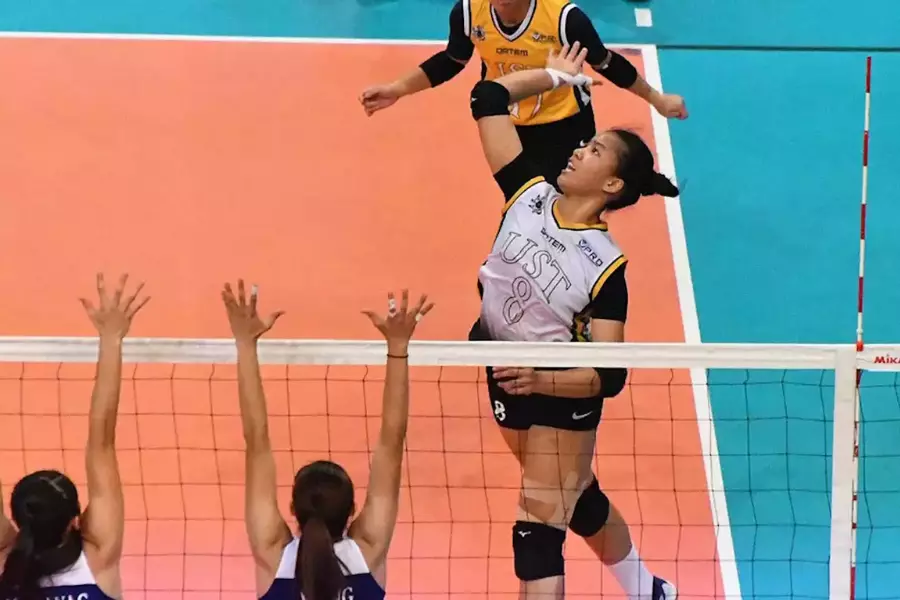
Outside hitters are probably as important as setters in volleyball.
On the court, it’s also one of the toughest positions.
It is important to have a good outside hitter on your team.
It is extremely important for outside hitters to hit the ball well since they receive the majority of sets.
A good player must perform under pressure and get kills even under tough conditions.
One must have confidence in one’s abilities and be willing to shrug off mistakes, refocus, and improve on the next point.
Is Outside Hitter A Good Position In Volleyball?
The outside hitters, to me, are the real rock stars!
Volleyball spikes are loved by all. A volleyball outside hitter is one of the most popular positions in volleyball because he spikes the most balls.
Having the ball in your hands allows you to make highlights like crushing it into the 10-foot line or shoveling your opponent.
It’s pretty cool, that’s for sure!
Outside, however, is a very challenging position.
You don’t play half the rotations as a middle blocker or libero.
Furthermore, because you are thrust into more offensive and defensive situations, you gain plenty of experience and touches.
Do I need to become an outside hitter?
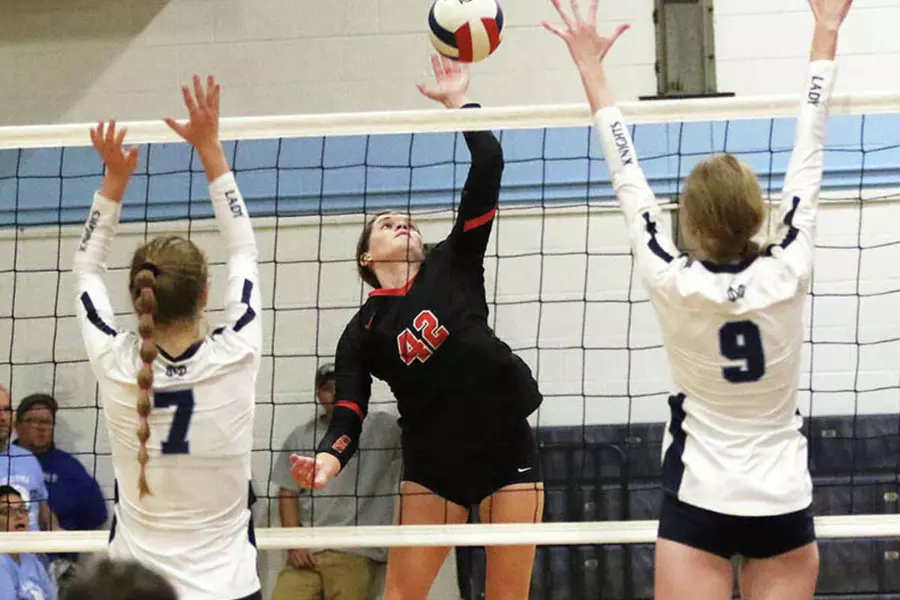
In short, how do you decide whether or not you should become an outside hitter?
To find out if you’re an outside hitter, let’s run through some physical characteristics.
Before you decide to pursue becoming an outside hitter, we will discuss a few other things to consider.
Outside Hitters’ Physical Attributes
See how many of the strengths listed in the section where I spoke about the strengths of an outside hitter relate to your own strengths.
Suitable height
It’s good news that outside hitters don’t need to be massive.
Outsides are usually a bit shorter than opposites and middles, but slightly taller than setters.
It is obvious that the taller you are, the better.
However, if you’re really tall, you may be better suited to be an opposite or middle blocker, where height is more desirable.
Check out my complete article on the height requirements for outside hitters to find out how tall you should be.
In great detail, it describes the height requirements for men and women at various levels of the game.
Decently Athletic
What is your level of agility? Are you capable of jumping decently?
When you’re in the air, do you maintain good body control?
Balance, speed, and coordination are essential for outside hitters.
Can you tell me how strong and powerful you are? Do you have the ability to consistently kill the ball or do your attacks often get dug up?
You can develop all of these attributes over time, so don’t worry if you don’t possess them yet.
Decent At Passing
What is the accuracy of your ball passing?
When serving and receiving, do you often make perfect passes?
Are you having trouble contacting the ball consistently?
As with the previous one, this can be improved with practice.
An outside hitter’s personality traits and attitude
A successful outside hitter must also possess a few intangible traits.
Confidence
A good outside hitter needs almost cocky confidence.
It’s all about you. There’s no doubt that you’re a star.
To back it up, you must have the skills.
As an outside hitter, there is nowhere to hide on the court. As a member of almost every committee, you must be confident of your abilities to complete the task.
Work Well Under Pressure
An outside hitter’s job is to make the best of a bad situation, which involves hitting tricky balls.
The first set might go well for you, but can you keep your head late in the fifth set when your team needs you most?
You’re just one point away from losing the match, do you have the confidence to swing aggressively?
Effective communication
Communication between outside hitters and the front-row players is a big responsibility.
In addition to calling out which players are running which attacks, they also point out where the setter is located and what combination plays should be watched for.
As the match progresses, they are continually calibrating their blocking strategies in conjunction with the middle blocker.
If you still don’t know if this position is right for you, check out my article about what things you must consider when choosing a volleyball position.
How Do Coaches Choose Outside Hitters?

Recruiters and coaches both look at outside hitter prospects from different angles.
Recruitment of outside hitters
| Skill | College Average | 80th percentile of College Average |
|---|---|---|
| Standing Reach | 7’9″ | 7’10.5″ |
| Attack Jump | 9’1″ | 9’5″ |
| Vertical Jump | 19.9″ | 22.6″ |
| Block Jump | 9’1″ | Standing to Reach |
We’ll begin by taking a brief look at a few guidelines for recruiting outside hitters.
Ability to jump an arm-length
According to the NCSA website, the following numbers apply to women’s volleyball.
In my opinion, recruiters are unlikely to get excited about a recruit with the same block jump as their attack jump.
Despite the fact that official men’s recruiting guidelines have not been published, I have noticed that a top-level outside hitter will have statistics similar to those listed below. Outside hitters tend to pay less attention to standing reach, which is more relevant to middle blockers and opposites.
| Skill | Benchmark |
| Standing Reach | 8’2″ (249cm) |
| Attack Jump | 11′ (335cm) |
| Vertical Jump | 35″ |
| Block Jump | 10’8″ (325cm) |
This stat is primarily concerned with spike height (attack jump).
It is reasonable to expect something over 330cm as a good size, but the height needs to improve over time.
A spike height of 345cm is required to play professionally as an outside hitter.
Hitting Percentage
As a spiker, your hitting percentage measures your efficiency.
Outside hitters should aim for 0.325, which is a good benchmark for recruiters who don’t have access to these stats.
According to position, I wrote an article explaining what hitting percentage is, how it’s calculated, and what figures you should aim for.
See how you’re doing there to see how you’re doing.
Height
Different positions require different height benchmarks. The outside hitter doesn’t have to be the tallest player on the court, but they can’t be short either.
Experience
It’s important to have played enough club volleyball to be considered by recruiters.
Ideally, they want at least 2-5 years of decent level competition.
It’s basically about showing them that you know how to act on the court.
Outside Hitter Coaching Guidelines
Coaches are always looking for small details when selecting outside hitters.
In addition to physical attributes, attitude and how you behave on court matter a lot.
We have already discussed some of these things, but let me explain why they make coaches happier.
Leadership Skills
Outside hitters should think of themselves as captains of the front court.
Taking responsibility for a large portion of the offense falls on them as the primary attackers.
In tough situations, teammates need to remember the game plan and keep a cool head.
Communication Skills
It’s not a good thing when an outside hitter is quiet, even if they are skilled.
Among the front-row communicators, you need to be one of the most vocal.
As you discuss the opposition’s formation and blocking tactics with your middle blocker, keep them constantly in the loop.
Keeping in touch with the setter also ensures you get better results, so you can kill more balls by giving them feedback on what works and what needs improvement.
Volleyball IQ
There’s a big difference between an outside hitter with good technical skills and one with a deep understanding of the game.
Choosing the right shots at the right time is crucial to success.
Blocking is all about reading the defense.
Knowing how the opposition plays and where the setter likes to set is important to getting in the setter’s head.
In order to win, you must understand what combo plays your opponent prefers, formulate a smart counter, and communicate it effectively to your team.
How To Be A Better Outside Hitter
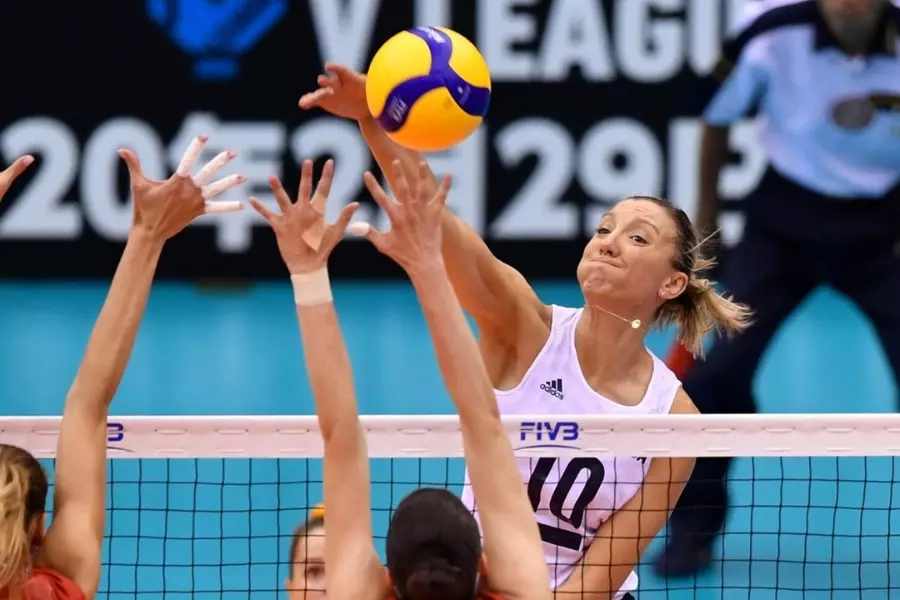
The outside hitter position in volleyball has the advantage of being highly trainable in many areas.
It is not necessary for brilliant outside hitters to be tall or heavy like opposites and middle blockers.
A volleyball player’s ability to improve depends a great deal on how hard he or she works.
There are many ways to hit outside, but I’ve decided to reveal the 20% that will yield 80% of your results.
To become a better outside hitter, you must focus your time and effort on the following three things.
Pass More Time
Ideally, passer-hitters should pass the ball really well.
By bypassing more balls, you will become a better passer.
In order to improve as an outside, you will pass more balls each week than your opponents.
Get a friend to serve you repeatedly in court.
It’s also a good idea to use a serving machine if you have one available.
If you play an extra game of pick-up volleyball each week, those extra reps will make a big difference.
Make More Hits
It’s the same with hitting…
Do you want to become a better hitter? Increase the number of balls you hit. Simple as that.
Each week, drag one of your setters to the court to do some extra work.
It would be ideal if you could find another hitter to block while you hit.
It would be good if you both alternated. You can read types of hits here.
It is critical that you are highly focused and deliberate in this area as well, rather than just going through the motions.
Formulate a plan. It might look like this.
- Sharply hit five balls down the line
- Aim for the back left corner with 15 balls
- Hit 5 balls sharply across the court
- Back right corner with 15 balls
It’s your mission to never get your stuff blocked once if you have a blocker.
You might want to hit 5-15 balls high off the block as part of your plan.
You have no excuse not to do more hitting repetitions.
There is no need for more than a net, a setter, and another hitter/blocker who wants to improve as well.
Live the weight room life
It is essential that you are able to jump as an outside hitter.
It is true that the vast majority of us do not have the gift of being springy, but some of you do.
Increasing your spike height should be your primary strength and conditioning goal.
Outside hitters should aim for 345cm spike height or higher if they wish to play volleyball internationally, while women should aim for 320cm.
In order to hit the ball harder, you must also train your upper body.
For some great drills to improve your spiking ability, head over to this article.
Can You Be A Left-Handed Outside Hitter?
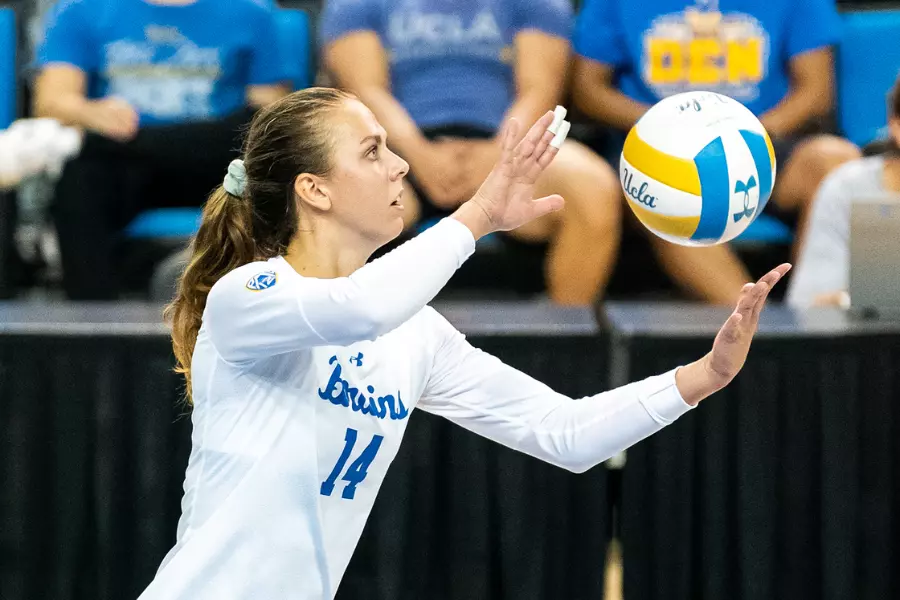
Outside hitters with left hands are definitely possible!
Due to the fact that it has to cross your body before hitting the ball, it’s less common.
Since right-handed hitters won’t have this problem hitting from the right side of the court, most left-handed hitters will gravitate towards the opposite position.
You can definitely be an outside hitter if you’re an excellent passer and enjoy hitting out of the left side.
In addition, some high-level professionals have successful left-handed outside hitters, such as Uro Kovaevi of Serbia.
Volleyball Outside Hitter FAQs
Can an outside hitter hit from the back row?
In many cases, outside hitters will hit from the back row.
In most teams, the outside hitter defends from position 5, but sometimes the libero switches the position of the OH, allowing the OH to hit the pipe from the back row.
Is the outside hitter the strongest hitter in volleyball?
There’s no way to tell, but it’s probably not the case.
It is common for opponents and middle blockers to be taller, so their levers can be longer, and therefore they can generate more power and strike the ball harder.
What are some outside hitter volleyball quotes?
In my opinion, there is no such thing as a block.“
Is outside hitter the coolest position in volleyball?
The outside hitter position in volleyball is undoubtedly the coolest.
Conclusion
The Outside Hitter volleyball position is a challenging and multifaceted position that requires a combination of power, finesse, and strategic thinking. A volleyball player must not only be an athlete but also a strategist, constantly adapting to the ever-evolving game.
You can also read Hardest To Easiest Positions In Volleyball

